The Beers of Britain and the Pubs That Love Them
The British have left such an indelible mark on brewing traditions throughout the world that they’re often taken for granted. The American pale ale, which has become a reliable staple for craft breweries across the United States and other regions of the globe, would not even be a thing had it not been for its venerable English ancestor. The same goes for the India pale ale (IPA). American brewers adapted and reinvented the style in the late twentieth century and made international drinkers fall in love with the hop-forward brew, but had British brewers not overhopped the ale to survive the circuitous, nearly 20,000-mile ocean journey to satisfy thirsty soldiers and sailors stationed in South Asia, what’s now the most popular craft beer style would never have been born—much less have such a household acronym. Also, the notion of the “session beer” that’s sweeping the nation after an extensive period of high-ABV obsession? That’s just “beer” to the Brits.
The next time you walk into a bar and hear someone ask “what’s on cask?” remember that the term would never have even been used in reference to twenty-first century beer had it not been for the way English ale has been served and enjoyed for centuries.
Britain is one of those places in which where you drink is as important as what you drink. While it’s perfectly fine to buy some pint bottles at the local Tesco or Marks and Spencer and bring them home to enjoy with dinner or in front of the telly, it is much more British to drink them at the pub. (And you’d better hurry up and do so because the classic British pub is a dying breed.)
For travelers touring the United Kingdon, drinking at a pub, whether it be in London, Manchester, Edinburgh, Glasgow, or Cardiff, is about as much of a cultural experience as visiting the plethora of history and art museums, watching a football match, and going to the theater. So it’s important to include a pub crawl on the sightseeing portion of an itinerary rather than just relegating it to the “nightlife” elements. There’s as much history contained inside the four walls of, say, Ye Olde Cheshire Cheese on London’s Fleet Street as there is in the British Museum. It may not be as obvious and displayed behind a glass case, but it’s there, and the bartender will be more than happy to discuss it with you over a pint or two.
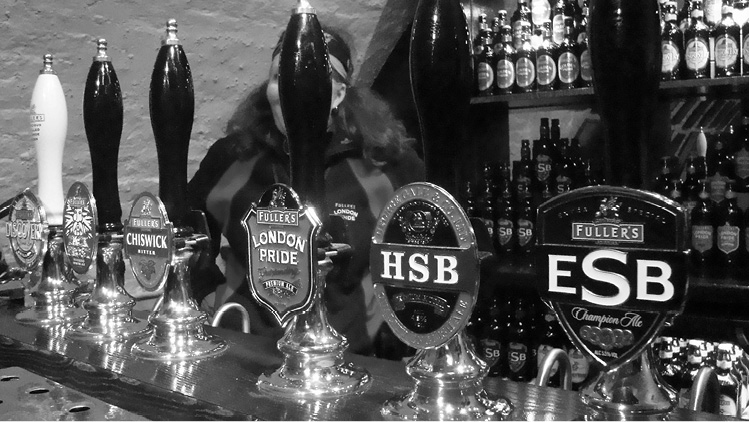
The UK’s ubiquitous hand pumps, dispensing cask-conditioned ale.
There’s a bit of etiquette for anyone who desires to order a pint at a British pub. Before you try to make eye contact with the barkeep—before you even approach the bar proper, for that matter—figure out what you want. If you’re standing at the bar with a blank, indecisive look on your face, your bartender and the other pubgoers waiting to place their order will be visibly miffed. And, when it comes time to get the bartender’s attention, do not wave money in his or her direction. That is truly bad form and is more likely to get you ignored than anything else.
Feeling peckish? If the pub serves food, don’t sit down at a table and expect the waitstaff to come and take your order. Read the menu, make a decision, and order at the bar. Then go back to your seat. They’ll bring it out to you. (This applies only to pubs, mind you. Don’t try this is at a regular restaurant.)
If you’re with a group, it’s traditional for individual members of the group to each buy a round at some point—depending on how large the group is, of course. You definitely don’t want to be the only one who hasn’t bought a round. It’s fairly bad form.
One of the sadder aspects of British drinking culture is that the same type of industrial macro lagers prevalent in the United States and other parts of the world have come to dominate the fridges and taps of even the most traditional of pubs. Preserving traditional British ales has been the raison d’etre of the Campaign for Real Ale (CAMRA), an organization that launched in the early ’70s as those mass-produced, light lagers had already significantly encroached on the most British of drinking institutions.
The “real” ales to which CAMRA’s proper name refers are essentially unfiltered, unpasteurized top-fermented beers served from special casks (originally wood, now predominantly metal) and containing live yeast cultures. There’s no forced carbonation and the beverage is delivered via gravity or a hand pump that’s part of an apparatus often known as a beer engine. Because the beer is a living thing, it has a very limited shelf life. It’s pretty much past its prime after a full day or day and a half on the bar. Publicans must take great care to keep it at an optimal temperature to enable the yeast to continue to thrive. And, because all of the carbonation comes from the secondary fermentation in the cask, it’s not always consistently carbonated.
For the most part, CAMRA has succeeded in its mission, as traditional, so-called “real ales” have survived and retained a loyal, albeit niche following. Such beers represent about 10 percent of the entire UK market, but without CAMRA, it’s very likely that that number would be pretty close to zero.
British Breweries: Something Old, Something New
In most countries, including—well, especially—the United States, if a brewery claims a century-plus of history, usually that brewery (with a few notable exceptions) barely resembles that which it once was. And these breweries are often complaint magnets for beer drinkers, “The Man.” Not so in some of the UK’s more revered establishments. Fuller’s is probably the best example of this dynamic. Founded in 1845, the company officially known as Fuller, Smith and Turner Plc is a respected London institution that continues to produce real ales of mostly unimpeachable quality. (That’s not to say it doesn’t have its detractors. Everyone needs something to complain about.)
The brewery, known for London Pride pale, Fuller’s E.S.B. (Extra Special Bitter), and London Porter—the yardstick against which all other porters should be measured—has, since its founding, occupied its stately Griffin Brewery in the West London district of Chiswick. The brewery building itself is much older than the company that owns it, as it housed brewing operations for long-defunct proprietors as far back as the seventeenth century.
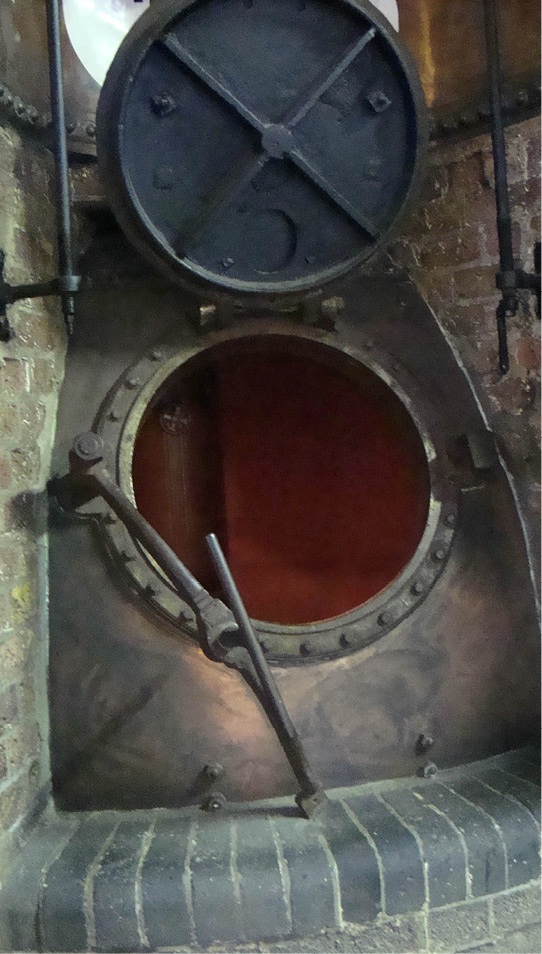
The Fullers tour offers a treasure trove of out-of-commission eye candy.
There are also plenty of London beer enthusiasts who resent Fuller’s seeming ubiquity. It owns around four hundred pubs throughout southern England with a disproportionate number in the capital city itself. As for Chiswick, they might as well just rename the place “Fuller’s.”
But a drinker is unlikely to sample a better imperial pint of London Porter anywhere in the world other than the space within a two-mile radius of the Griffin Brewery. Even those in the “I don’t like dark beers” crowd are likely to experience a near-religious conversion whilst in Fuller’s orbit.
And then there’s the brewery tour. All of the new upstarts are well worth touring. However, like most craft breweries, they’re just unassuming industrial buildings with lots of stainless steel tanks inside. They get a little samey after a while (though there’s no better place to sample their products, so by all means, old or young, don’t avoid any of them.) Fuller’s is living history. Sure, there’s plenty of high-tech equipment there, but the powers that be didn’t throw the baby out with the bath water. Much of the nineteenth century tech is still there for ornamental and educational purposes, and the fact that it was once in use at that very spot makes it so much more than a museum.

A rather noirish look at the exterior of Fuller’s Griffin Brewery in Chiswick.
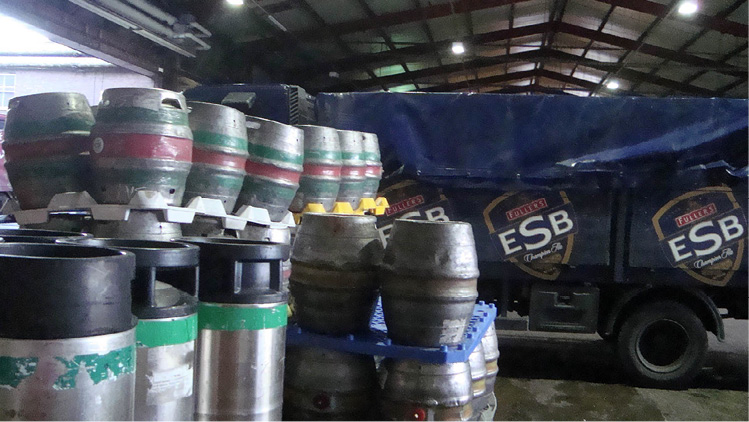
Real ale casks at Fullers.
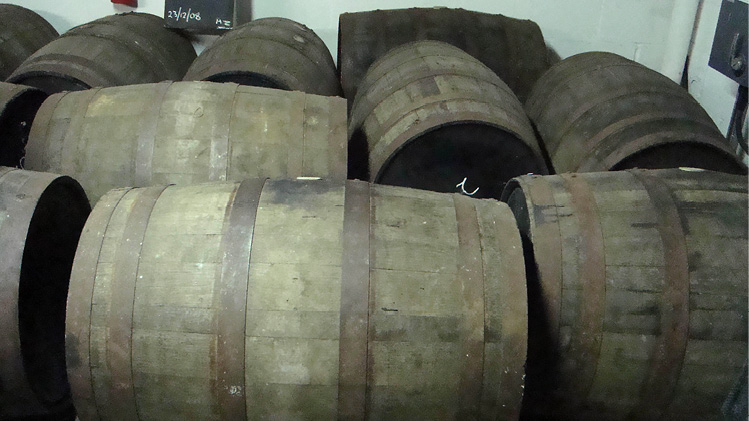
Fuller’s boasts a world-class barrel-aging program for some of its smaller-batch brews.
Classic British Pubs
A new wave of beer bars has swept through the United Kingdom, offering stunningly long draft and bottle lists that feature selections not just from British breweries but from the Yanks and continental Europeans, as well. But we won’t get into those bars quite yet; a couple of them will be featured later, in the section on the best international beer bars. Here, we’re going to cover the classic “locals,” the pubs that have survived city-leveling fires, political upheaval, plague, and the Blitz.
Pubs typically fall into one of three categories: managed, tenanted, and free houses. Individuals in the employ of pub chains run locals of the managed variety. Meanwhile, pub corporations or breweries themselves own the building and all of its décor and equipment, which the pub’s “landlord” rents from the owner. Free houses are just as the name suggests, free of ties to a larger corporation or brewery and owned by private individuals. The main difference between managed and tenanted pubs is that in the former, the parent companies and/or breweries exercise complete control over what’s served at the bar (this is known as the “tied-house” system, which the Twenty-first Amendment prohibits in the United States), and with the latter, the owners have considerable, but not absolute, influence over what the drinking venue stocks. It’s fairly common to enter a pub with six to eight cask hand pulls for different styles of beer, but, upon closer inspection, you’d see that they’re all from the same brewery. And that’s not necessarily a bad thing, considering the quality of some of those breweries, which include fine purveyors of real ale like Fuller’s, Greene King, and Adnams.
As for free houses, since they’re not completely beholden to corporate parents, they can usually carry whatever they choose (theoretically—at the end of the day it’s up to what patrons ultimately buy, and, more cynically, whichever beer suppliers make the best sales pitch).
CAMRA’s mission also extends to preserving real ale’s optimal drinking environment: the classic British pub. In recent decades, generations-old drinking establishments have been closing fairly rapidly, but perhaps not as fast as they would have had CAMRA not been on the case.
Ye Olde Cheshire Cheese (London)
Locals will tell you that Ye Olde Cheschire Cheese is mostly a tourist spot, and they’d be, for the most part, right. But that doesn’t mean it’ s not worth checking out, even for just a quick look-see. It’s a bit of an institution; there’s been a pub at its site since 1538. The round, illuminated sign dangling outside the pub reads “Rebuilt 1667.” That, of course, is a year after the Great Fire of London. The interior reveals quite a bit of old wood on the floors and paneling—it’s not likely that most of it goes all the way back to the seventeenth century, but there’s definitely some nineteenth-century carpentry going on there. It’s nothing short of cavernous, with lots of nooks and crannies—some fairly intimate, others more partylike—on two levels. There aren’t any windows, so absolutely no natural light makes its way inside. It adds a bit of spookiness to the experience, and it also helps sell the trip-back-in-time aspect. As is common with many of the classic pubs throughout the UK, it’s operated by a single brewery—in this case, the Samuel Smith Brewery in Tadcaster, Yorkshire. Sam Smith brews are easy enough to find in the US, but there will probably be a couple on draft at Ye Olde Cheshire Cheese that don’t make their way to these shores. And there’s probably no better environment in which to try them. Unlike many of the generations-old brewing companies on the British Isles, most of Sam Smith’s ales are not on cask; rather, they’re on traditional draft.
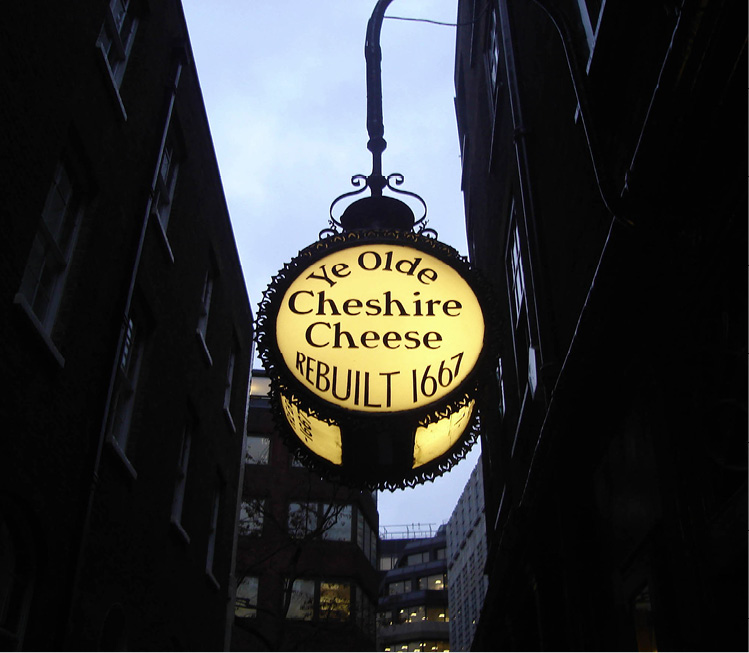
London’s Ye Olde Cheshire Cheese.
The George Inn (London)
This one has so much history embedded within its walls that an entire book has been written about it. Renowned British beer and cider writer Pete Brown’s Shakespeare’s Local: A History of Britain Through One Pub details the storied past of the George Inn, which is located in the Southwark neighborhood near London Bridge. Charles Dickens frequented the spot and, as the title suggests, William Shakespeare may very well have sipped at the location, as well. It’s located fairly close to the original site of the Globe Theater, so there’s a good chance (though no definitive proof) the Bard got his drink on at the George. The pub is quite spacious, as it’s been built up over its six or so centuries of existence. There’s a standard bar area, a roomy dining/drinking area in the back, and a function room upstairs with its own bar. There’s also a fairly large courtyard outside with communal tables for those more temperate days (it’s also the only place for smokers, as London has had an indoor ban for many years). Real ales on hand pump are mostly from Greene King brewery, but there are plenty of guest beers as well.
The Blackfriar (London)
Part of the Nicholsons chain, the Blackfriar has been at the space since about a decade before the outbreak of World War I. The establishment’s monastic imagery is a nod to the Dominican friary that once stood at the site. It’s one of handful of pubs throughout the British capital that’s as much a sight to behold on the outside as it is on the inside. The pub is nestled inside a narrow wedge-shaped structure, not unlike Manhattan’s famous Flatiron building, albeit considerably smaller. Blackfriar’s aesthetic adheres to the Arts and Crafts movement, of which the building’s designers—architect H. Fuller Clark and designer Henry Poole—were a part. It’s impossible to get bored while sipping the freshest offerings from the likes of Greene King and Adnams and dousing your fish and chips with malt vinegar. The space is a veritable gallery of monk-centric sculptures, paintings, and mosaics. Even when the place gets jammed with people (especially during lunch and after work), there’s still a laid-back, relaxing vibe. A bit of a religious experience, one might say.

London’s classic Blackfriar pub.
A Not-So-Old Pub with a Classic Feel: The Knights Templar (London)
Though it’s part of the Wetherspoon family of pubs, the Knights Templar on Chancery Lane in London is, visually, its own beast to behold. The interior offers some gilded architectural eye candy, which is appropriate since it occupies the former site of the Union Bank. High, vaulted ceilings (up to twenty-five feet!), towering columns, chandeliers, and ornate trim make this a great spot to duck into after a hard day’s work and get transported out of your own head and into another time. The pub takes its name from the Catholic Church-sanctioned twelfth-century military order. The Knights Templar is quite deceiving in its beauty. The antique décor makes it seem like the bar’s been there forever. The building may have some history to it—the erstwhile financial institution set up shop in 1865—but the pub itself didn’t open until the late 1990s.
The Kings Arms (Salford, Greater Manchester)
Manchester has long been famous for its music scene (Joy Division/New Order, the Smiths, the Stone Roses, Happy Mondays—too many to name), so it’s fitting that one of its institutions of fine drink and socializing now belongs to the singer of ’80s and ’90s New Wave and Britpop bands. In 2011, Paul Heaton—famous as the front man of the Housemartins and, later, the Beautiful South—bought a storied pub in the greater Manchester borough of Salford (birthplace of the aforementioned Joy Division). The brick Victorian-era exterior of The Kings Arms resembles a small castle as it curves around its corner. Inside the double-story structure, some of its late-nineteenth-century woodworking and tile remains, and its six hand pumps (lots of local stuff that’s hard to find outside of the north) make it a destination for cask ale seekers. But it’s the modern touches that keep it relevant for an evolving clientele. Comedy and live music acts (what else would you expect from Heaton?) keep butts in the seats and beer flowing constantly.
The Blue Blazer (Edinburgh, Scotland)
One of the great things about drinking at a pub in Scotland is that you can get a fairly high-end single malt Scotch for what you’d normally pay for a latte at Starbucks. And, believe it or not, a good Scotch whiskey pairs remarkably well with a fine Scottish (or English, for that matter) ale. Whiskey is just distilled beer; both libations pretty much use the same malt. File the Blue Blazer under “Scottish institution.” It’s in the Old Town, so there will likely be a fair number of tourists there, but a goodly number of locals should offset the out-of-towner population. It’s also an establishment that keeps its heart in tradition, while fully embracing the modern. In other words, there are plenty of hand-pulled Scottish 80-shilling real ales and such, along with selections from the new crop of craft brewers that have been popping up in Scotland and throughout the UK in the past decade. The pub manages to retain its classic feel with a bar made of dark wood and halved oak barrels mounted on the top shelf for added ornamental effect.
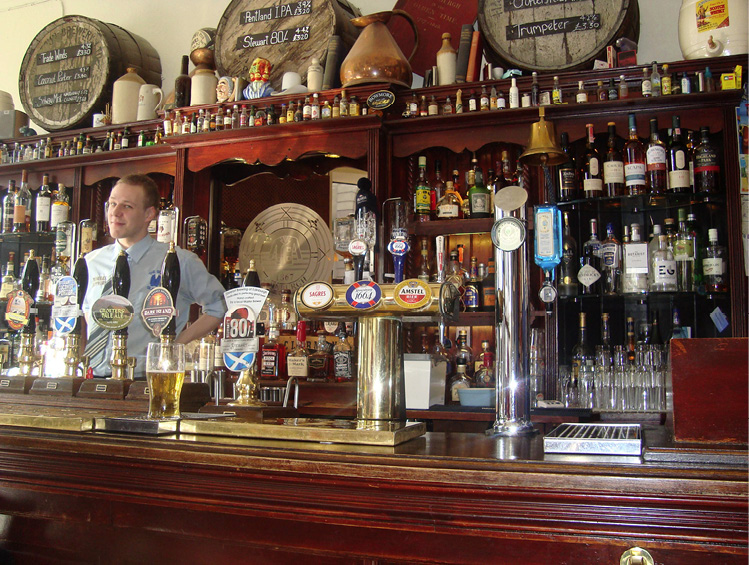
Edinburgh’s Blue Blazer is one of the better-known haunts in the Scottish city.